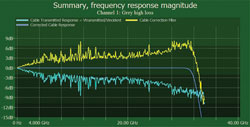
Companies spend large amounts of money on test and measurement equipment. One of the largest purchases for high speed designers is a real time oscilloscope. As is the case with most instruments, oscilloscope vendors charge a premium for cutting edge bandwidths. Companies are willing to pay this premium to be able to know with certainty that the device they are testing is being represented properly by the oscilloscope. An oscilloscope with too little bandwidth will under report rise times and in many cases, over report jitter. This leads to eroding electrical margins and increasing costs and time to market for a project and design. The benefit of higher margins makes the bandwidth premium a worthwhile investment.
Despite its cost, an oscilloscope is only part of the entire measurement system and precious measurement system bandwidth can be lost through other links in the channel system. One potential bandwidth bottle neck includes the cabling and adapters. Despite this, the characteristics of such adapters tend to be ignored. Compared to the price of an oscilloscope, the cost of a cable is very minor. Yet cables can wreak havoc on any measurement system. Beyond losing the biggest portion of the investment (the bandwidth) because of cable loss, precious margins are now lost as well. Amplifying the problem, companies now use more links in their measurement channels including switches (to measure multiple channels), adaptors and fixtures. Similar frequency responses potentially could be found in each one of these components, all causing erosion of crucial margins and potentially wasting hundreds of thousands of dollars. Yet the underlying theme is that the loss is largely ignored.
Agilent Technologies has published an article covering cable loss and how to adjust for it. It is available on the Microwave Journal website at www.mwjournal.com/AgilentCableLoss.
Agilent Technologies Inc.,
Santa Clara, CA
(800) 829-4444
www.agilent.com.
